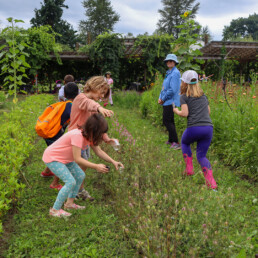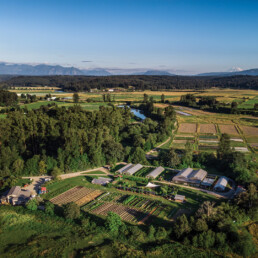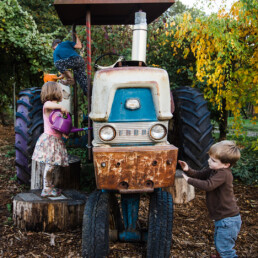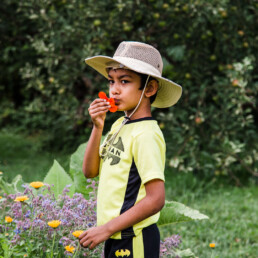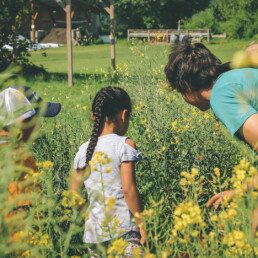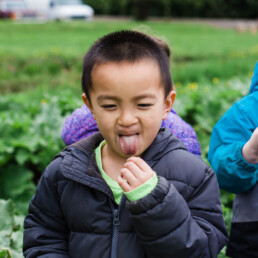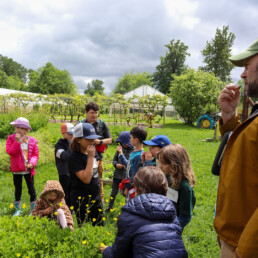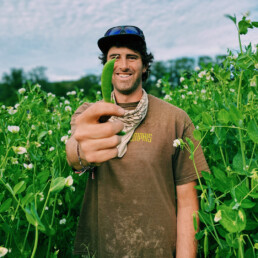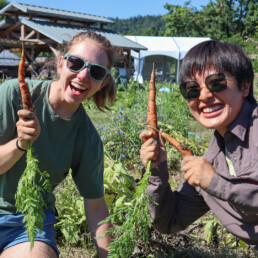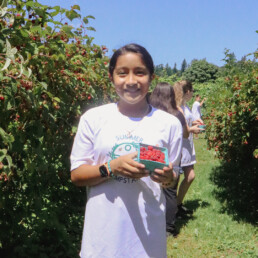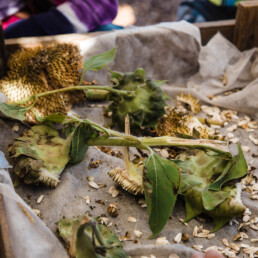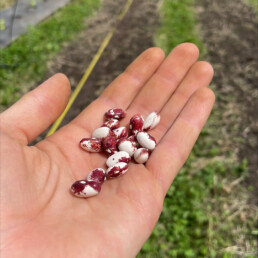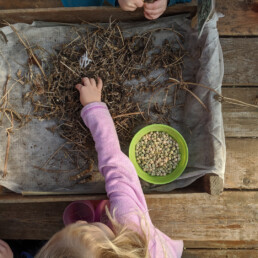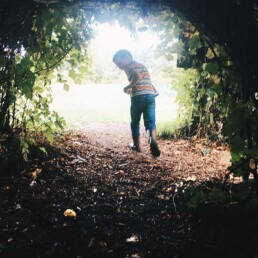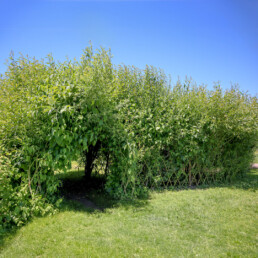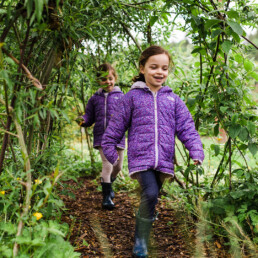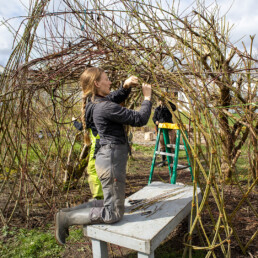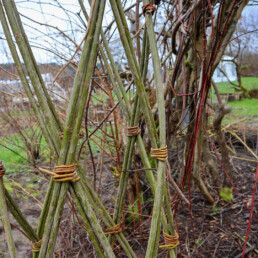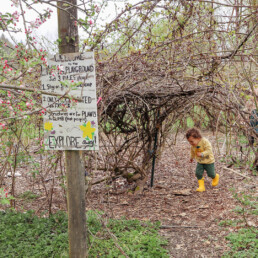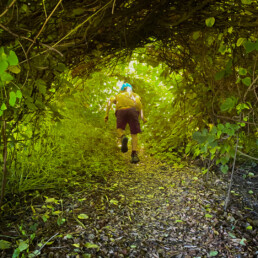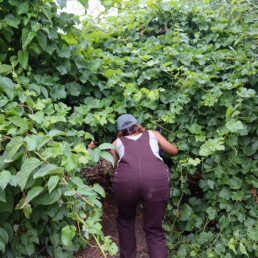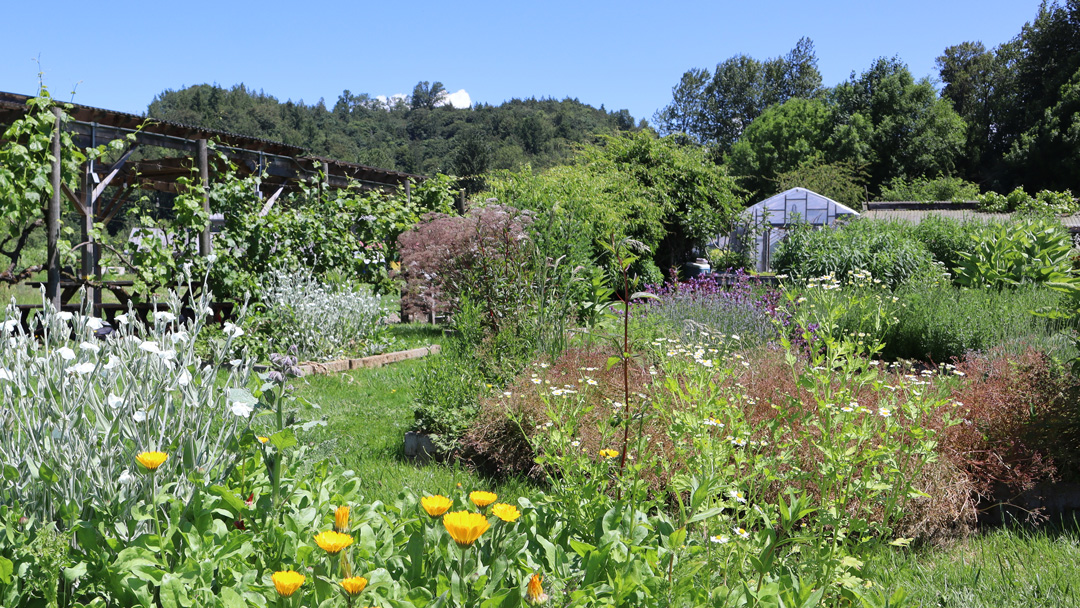Top 6 Kids’ Farm Fascinating Features
At Oxbow’s Kids’ Farm, curiosity and connection bloom as brightly as the flowers. Nestled between our barn and native plant nursery, this two-acre outdoor classroom includes a one-acre farm with dozens and dozens of annual edible plants growing at any given time, plus a one-acre “living playground” bustling with perennial herbs, flowers, and fruit—a true feast for the senses. Grape-draped pergolas and an outdoor kitchen complete this hub for events and interactive learning.
Every spring, summer, and fall, this space buzzes with group programs and camps, immersing learners of all ages in the wonders of nature. Curating this educational oasis is a collaborative effort between our Education Team (OxEd) and Garden Coordinator Lynnea, who designs each element with careful consideration. Every nook of the Kids’ Farm is packed with engaging attractions, including “Bubs,” the beloved climbing tractor, and numerous hidden gems. Ready to explore our top 6 fascinating features? Let’s go!
1. Rainbow Harvests
From April to November, visitors can find edible parts of plants in every color of the rainbow! From purple beet roots and pink chard stems to red-veined sorrel leaves and orange nasturtium flowers, Oxbow’s Kids’ Farm offers a novel opportunity to harvest, snack, and learn about plant life cycles and the six major plant parts. Folks may even discover exciting new ways to enjoy veggies they thought they knew inside out. For example, broccoli and other brassicas bloom with clusters of small yellow flowers on tall, slender stalks and produce seed pods, all of which are edible. Tiny sugar snap peas grow on vines that can reach up to 8 feet tall with the help of wispy, curly tendrils that grab onto supports to help the plant climb. Many people delight in discovering the tender plant leaves taste as sweet as the peas!
Oxbow Educator Momo Suzuki loves watching kids light up as they make deeper connections with foods they’re already familiar with:
“They come here with a piece of the puzzle, and then they get to see the whole picture come to life.”
Momo explains how special it is to see the entire plant life cycle in one place—from tiny seedlings and young sprouts to vibrant flowers and ripe fruits—especially since most farms clear plants after harvesting what they need to sell.
Coordinating the “Taste the Rainbow” experience from spring through fall is a remarkable endeavor, involving the meticulous management of weather considerations, plant timing, crop rotation, soil health, and over 130 species of plants for everyone to interact with. This colorful challenge showcases what makes Oxbow’s Kids’ Farm so unique and fun!
2. Local Seed Stewardship
In her planting decisions, Lynnea prioritizes the use of locally-sourced seeds to cultivate agrobiodiversity, climate resilience, and greater community seed independence. While there are hundreds or even thousands of varieties of most fruits and vegetables, the food in grocery stores represents only a small portion, chosen for high yields and storage qualities rather than nutrition, climate adaptation, or cultural importance. According to the Food and Agriculture Organization of the United Nations, 75-percent of the world’s food is generated from only 12 plants and 5 animal species. Growing a diverse range of crops and diversity within crop species helps ensure food systems are resilient to pests, disease, market fluctuations, and climate change. By collecting and replanting locally adapted seeds from our homegrown crops, including tomatoes and sunflowers, and by saving and exchanging seeds within our bioregion, we help support biodiversity and resilience within our community.
One notable effort is the preservation of the threatened Indigenous Ozette potato variety. Instead of perpetuating propagation with tuber clones, which result in more uniform plants and less genetic diversity, we aim to grow and save true potato seeds to continue the plant’s rich lineage. This potato has been cultivated in the region by the Makah Tribe for about 200 years. Research at Washington State University revealed that while all potatoes originate in South America, the Ozette is unique because it is believed to be the only potato in North America that came directly from South America without first going to Europe. It’s believed that after establishing a fort in Neah Bay in 1791, the Spanish abandoned it a year later, leaving behind this variety. The Makah adopted this potato as a source of carbohydrates, began growing and stewarding it, and named it Ozette after one of their five villages around Neah Bay. Although production of this seed has been limited, regional awareness is growing, and we aim to contribute to the local seed supply and help protect and sustain this valuable aspect of local agricultural heritage.
3. Magical Living Tunnels
The living tunnels are one of the most charming attractions at Oxbow. Using woven willow branches and native Red Osier Dogwood, these covered pathways create a whimsical space for children to play, explore, and take shade during sweltering days. They are not just visually captivating but also showcase sustainability and artistry. Perennials and trees sequester and store more carbon than annuals, drawing it from the air and depositing it into our soil, which is exactly where we want it! By pruning willow to foster healthier growth and creatively repurposing the trimmed material to construct the tunnels, we integrate functionality with beauty. The creation is truly more than the sum of its parts—it’s a touch of magic and the home to one of summer campers’ favorite pastimes, tunnel tag!
4. Financial Flexibility
Financial flexibility is a unique feature of Oxbow’s Kids’ Farm. As a nonprofit, we are not bound by the typical constraints of commercial farming, such as prioritizing high-value crops and maximizing space for profit. This freedom allows us to create a more dynamic and interactive environment for learning and play—literally and figuratively opening space for more diverse farm experiences. We incorporate wider paths between beds to accommodate large groups and different forms of mobility. Visitors can observe and interact with plants through every stage of their life cycle, even beyond the prime harvesting time, expanding their view and appreciation of the food system and ecosystem.
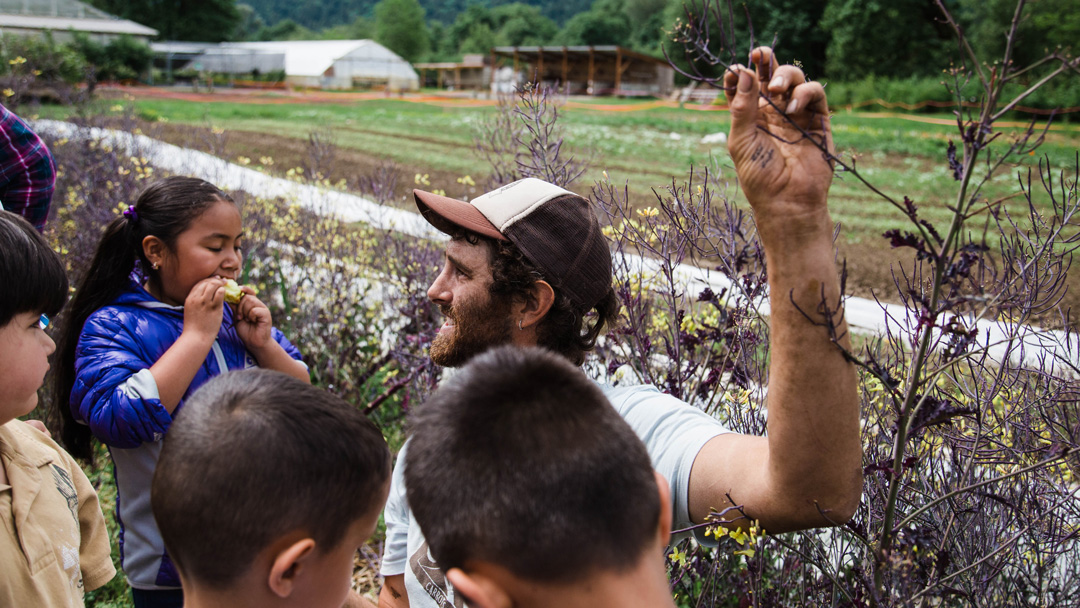
We understand that having such a special space for discovery and growth is a privilege made possible by the financial support we receive. We extend our deep gratitude to everyone who contributes to our work and mission by attending events, participating in programs, shopping at our Farm Stand, and providing funds through major gifts, grants, and public donations. Their generosity ensures that we can continue to offer this unique educational environment where nature and learning grow hand in hand.
5. Exciting Experiments
With our financial flexibility, we’re able to trial seeds and techniques that other valley farms may be interested in exploring, learning from, and utilizing but can’t afford to gamble on. Currently, we are practicing dry farming grains, with a focus on sorghum.
Sorghum is one of the most widely eaten grains in the world and serves as an important source globally for animal feed, biofuel, and alcohol. While it is culturally significant to regions of China, North and Western Africa, and Central and South America, it is not typically grown easily for grain production in the Northwest due to our long summer days that interfere with the rhythm of typical flower and seed production.
This season, we are excited to trial “Gaolian Voskovidnyj,” a unique sorghum seed with local roots. Originating from China and Russia, this variety was recently adapted to dry-farming conditions in Carnation by Chris Homanics. Its genetic diversity and drought tolerance show great potential for grain production in our area. We’re curious to see how it performs at our Kids’ Farm and are eager to share our findings. Positive results could be particularly valuable for homesteaders aiming to grow food for their families and animals on marginal soils without irrigation and for farmers focused on strengthening local food security.
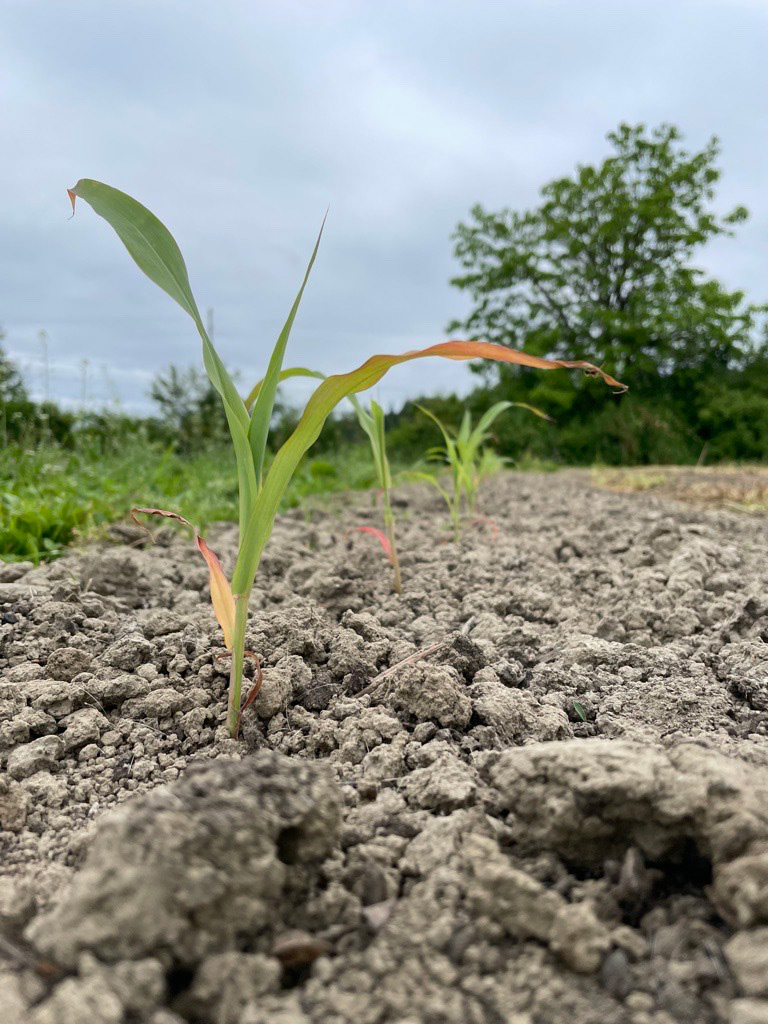
6. Culturally Significant Foods
For OxEd and Lynnea, growing culturally significant foods is part of their goal to help students and visitors feel they belong and can be their authentic selves at Oxbow. Kids are often eager to share about their home cultures, and it’s important to our team that they feel welcome and represented as much as we possibly can. We aim to have representation from across the globe such as chepiche de Oaxaca, chiles, grain amaranth, winter squash and melons indigenous to the Southwest and Mexico, native Wampanoag corn, shungiku, tatsoi, napa cabbage, Japanese slicing cucumbers, perilla, callaloo, collards, sorghum, and more.
Momo warmly recalls families from Frank Wagner Elementary expressing excitement over seeing familiar produce like radishes, tomatillos, and epazote. They add, “It was also really lovely to have Chef Sudeepa from Bangalore Kitchen and Chef Sara from OSHUN Banchan Deli & Cafe share how to turn local produce into South Indian and Korean dishes, respectively.”
What familiar or unexpected foods will you find? What other hidden gems will you discover? You’re invited to explore our farm and experience the wonders of nature.
Visit Oxbow
Enjoy trails, seasonal scavenger hunts, picnics, and more during Farm Stand hours. No reservation required.
Sign Up for Camp and Farm Adventures
Connect to the magic of nature and bring science, farming, and sustainability topics to life in a safe and meaningful way!
Attend Workshops and Events
Explore the outdoors, celebrate the seasons, and create magical memories.
Support Oxbow’s Work & Mission
Donations help amplify environmental efforts at Oxbow and beyond.
We’re Looking for Summer Camp Volunteers!
Join us for one session or all of them with the opportunity of earning up to 200 volunteer hours while gaining valuable leadership experience working with kids to support them as they build confidence and learn to safely explore outside.
Benefits include:
- Outdoor Facilitation Fun: Support campers as they explore, problem-solve, and gain autonomy in the great outdoors.
- Earn Volunteer Hours: Perfect for fulfilling high school graduation requirements.
- Test the Teaching Waters: Discover if a career in education is your calling.
- Hands-On Experience: Learn the ropes of working with children in an engaging environment.

